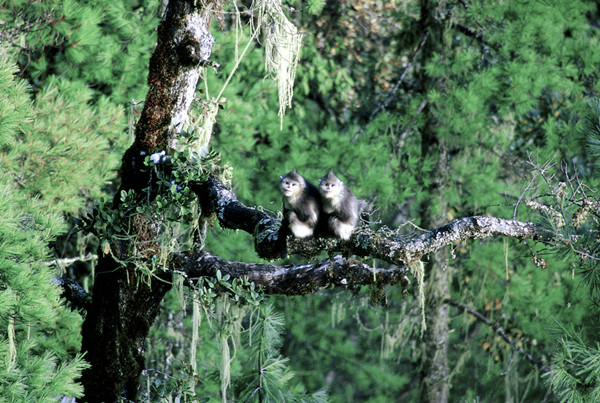Shooting for protection
- By Dolphin
 0 Comment(s)
0 Comment(s) Print
Print E-mail China Pictorial, September 4, 2013
E-mail China Pictorial, September 4, 2013
|
Yunnan Snub-nosed Monkey(Rhinopithecus bieti), Baima Snow Mountain, Yunnan, 2001. [Photo/Xi Zhinong/WildChinaFilm] |
To shed even greater light on this modern hero, China Pictorial recently interviewed Xi Zhinong.
CP: What are your thoughts about the many endangered species in China that still haven't been photographed? How is Wild China Film's "Endangered Species Image Project" progressing?
Xi: We all know that the Chinese river dolphin is already gone. Unfortunately, no pictures were taken when the Yangtze River was still clear. We still lack images of many amphibians and reptiles on the verge of extinction. These two classes have attracted the least attention because they are small in number and dependent on tiny, unique eco-environments. Many species could become endangered before they are even discovered and named. Our campaign is committed to taking as many photos as possible, to arouse systematic, enduring, and constant concern for every species in need.
CP: The Qinghai-Tibet Plateau, as well as regions around the source of the Yangtze, Yellow, and Lancang Rivers, are home to myriad species of wildlife. Has human activity, including industrialization and urbanization, threatened the survival of wildlife?
Xi: Yes, of course. Many wild animals are struggling to find a place amongst the concrete of urban areas. Images are the best force capable of moving people to protect the few natural, wild animals teetering on urban fringes and in the cracks of concrete walls. I advocate everyone photographing local wild animals, so that local residents can better understand the species and take an active part in protection. For example, birdwatchers in Xiamen, Fujian Province, captured images of Purple Swamphens, which were thought to have disappeared there a century ago. Locals thus pushed to stop development over wetlands for the sake of the rare birds. The local government has responded and offered compromises.
CP: Why do people think it's more difficult to capture pictures of wild animals in China? After your 20 years of experience, do you think the situation will improve?
Xi: China doesn't have too many large mammals, which are highly sensitive to man's presence. Moreover, China's wildlife photography isn't yet mature, making good photographs of wild animals rarer.
However, things are getting better in some places. More protection zones have been established. Logging in more forests has been banned. Nature is back. Many species of wild animals are recovering. Nevertheless, we are still a long way from optimistic in terms of the big picture.
We need greater efforts to refresh old attitudes and ideas about nature. The relevant systems and mechanisms have yet to be adjusted to adequately regulate commercial logging, development, and hunting.
CP: What's the biggest difference between China and other countries in terms of wildlife photography?
Xi: Many older Chinese people first learned about many wild animals from a TV documentary, Wild Life, filmed by a top international crew 30 years ago when China was not ready to photograph wild animals. They saw emperor penguins in Antarctica and witnessed gnu migration in Africa, but were left with little knowledge about their local wildlife.
In many countries, wildlife photographers hold biology Ph.Ds, or at least some biology education. Wildlife photography is a sustainable, long-term profession that requires high specialization, professionalism, systemization, industrialization, and socialization. Photographers can make a living. Nevertheless, the trade has not yet gained traction in China. I do hope that Wild China Film can contribute to the progress of wildlife photography in China.







Go to Forum >>0 Comment(s)